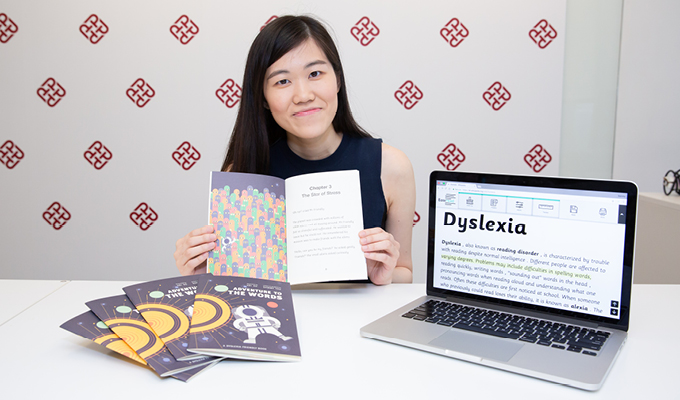Reading is a challenging task for people with dyslexia. Faced with the same difficulty, School of Design graduate Sammy Yau developed a smart typographic generator, Easiread, which provides a solution to those with reading difficulties. In this issue, Sammy shared her journey in developing Easiread and turning it into a start-up.
1. What inspired you to develop Easiread?
I have had mild dyslexia ever since I was a kid. I am a slower reader and very often I could not recall what I have been reading. I had to spend much more time on homework than my classmates. During my studies in the School of Design’s communications design programme, I was inspired to utilise different fonts, colours and typography to help improve my reading ability. As such, when I was thinking of ideas for my final year project two years ago, I decided to help others in need based on my own experience.
2. How can Easiread help those with dyslexia or other reading difficulties?
When people with dyslexia read, they often see words backwards, float on the page and jump around. This greatly lengthens the duration to complete a piece of reading. Easiread is a customisable typographic generator that enables users to choose text font, font size, line spacing, and background colour, and to follow the text line by line via a tracking tool so as to enhance reading accuracy.
3. How effective is Easiread?
To test the effectiveness of Easiread, two experiments were conducted on 32 primary two to secondary two students with mild to moderate dyslexia. Each student was provided with two English articles with similar content and level, reading one article using Easiread and the other without. Researchers observed the students’ reading behaviours, recorded the reading time required and asked them questions related to the articles. Results revealed that with the help of Easiread, not only did the average reading time shorten, reading accuracy also improved significantly.
4. Please share your journey in turning Easiread into a start-up.
With the encouragement of my tutor in the School of Design and start-up support provided by PolyU, I decided to commericalise Easiread so as to benefit people with dyslexia. In January 2017, I partnered with a classmate in founding the start-up Easiread, and have received support from various sources, including PolyU’s “Good Seed” programme, HKSTP-PolyU Tech Incubation Fund Scheme and PolyU InnoHub.
5. What are your future plans for Easiread?
Currently, Easiread can only be used on Google Chrome for browsing the English version websites of Wikipedia. It is planned to develop programmes suitable for other websites and offline versions to enhance users’ reading fluency for e-books and downloaded documents.
